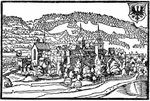


Light troops were much in demand in North America and "the most active resolute men" from the regular line regiments were selected to form a body of Light Infantry. Generals Amherst and Wolfe ordered their light infantrymen to put the sleeves of their coats on their waistcoats, add wings like those of grenadiers but larger and to extend down the sleeve, to have no lace but to keep the lapels, and to add two extra pockets of leather for ball and flints. They were to carry a knapsack "as the Indians carry their pack", that is, very high between the shoulders, have a cartouche box under the arm on the left side suspended from a leather strap, carry a canteen covered with cloth under the knapsack and have a tomahawk in a rough case with a button in a leather sling at the side. Fusil, bayonet and powder horn were also carried. The leggings had leather straps under the shoes and the tricorn hat was cut down into a cap and flaps added so that it could be fastened under the chin for warmth. The result was not pretty and must have given many of the more traditional officers and NCOs apoplexies but it was practical.
Initially the light infantry fought with the rangers on guerilla operations but in 1759 they led the army up the Heights of Abraham to Quebec. In 1760 they were returned to their regiments but the experiment was not forgotten and in 1770 line infantry regiments were given light infantry companies to make 10 companies per battalion (including 8 battalion or "hatmen" companies and a grenadier company). (Already in 1755 some regiments had been experimenting with "picquet" companies which were also forerunners of the light company and which were copied from the French.)























































